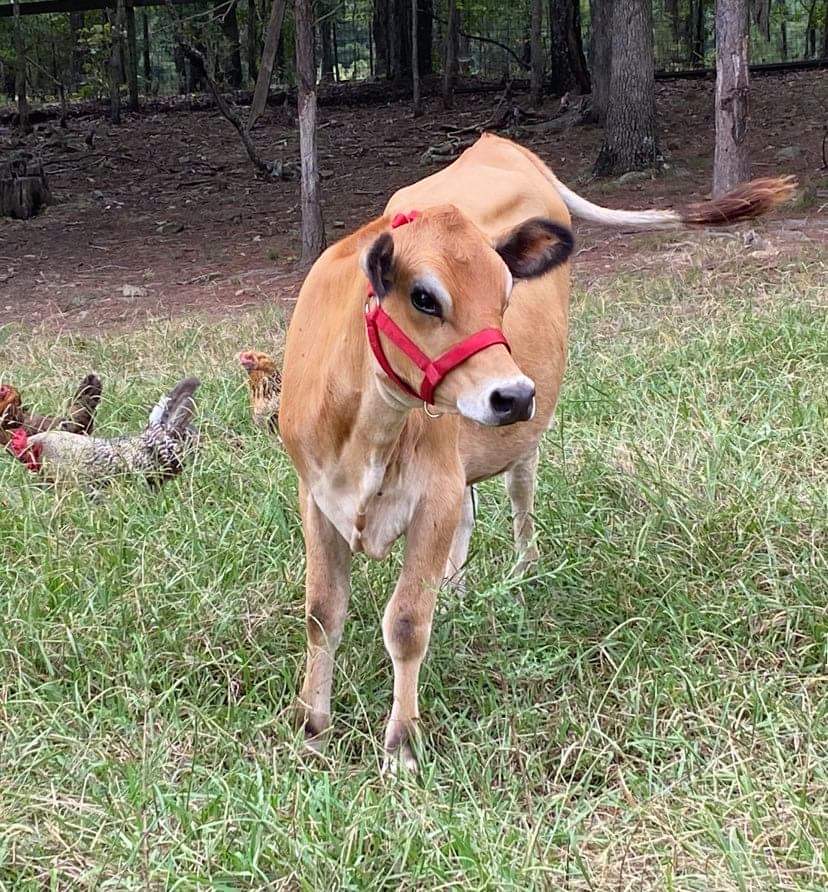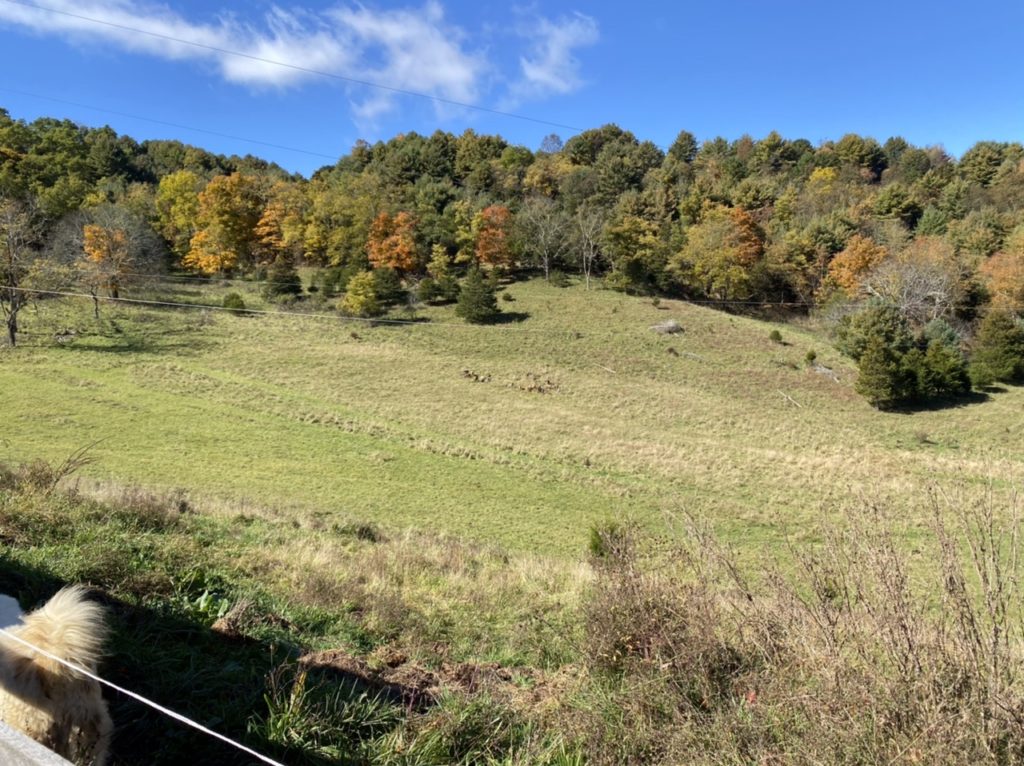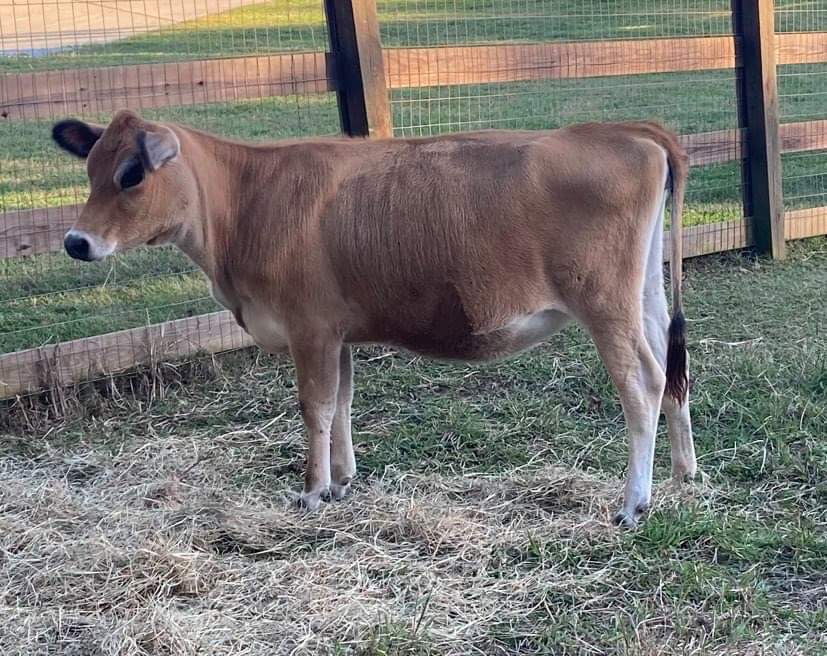In November of 2020, we started a new adventure: we purchased our first Mini Jersey cow. On this page is the story of how we came to decide to keep and breed these gentle sweethearts. If you want to see pages for our individual cows, and breeding plans, please use the drop down menu from our home page, or go to the bottom of this page for helpful links.
Why Mini Jerseys?

Well, first of all, how could you resist a face like that?
But seriously… it was about our land, most of all. We are blessed with 40 total acres. Our house and other buildings in our home complex sits on about three of those. Another three are paddocks that are sub divided. That leaves about 27 acres in pasture and woods. About 17 of those are pasture.
You many not know this, but if you don’t have grazing animals on cleared pastures, they won’t stay cleared for long. They will sprout weeds, bracken, and then young trees. In about 20 years, you’ll have a young forest, not pastures.
We have goats. (You probably know that.) Goats are browsers, not grazers. Like deer, they eat at nose level, and they choose bracken, rose bushes, pine trees, fallen leaves, and weeds about grass. Grass is their last fodder of choice.

So, as we look out over our back 27 acres, we see lots of grass—in fact, let’s play a game. See if you can find our entire 25-goat herd in the picture below.
This is maybe 7 of our 17 pasture acres. Can you find our goats? THIS is why we need cows. Though we have two horses, they aren’t nearly enough to keep up with our pastures.
So, we decided on cows. “But why miniature Jerseys (you may ask)? If you want to have grazing animals, why choose small ones?”
Good question! So glad you asked…
As with Mini Nubians, smaller is better for a variety of reasons. Smaller cows are easier to manage, they eat less, they require less square footage in terms of shelter, and you can fit more of them on your land than you can fit standard sized cows. They also give less milk, but that is a good thing in the eyes of many who keep them.
The milk of a Jersey cow is renowned for its creaminess and flavor. It is great for making cheeses, butter, and cream (including ice cream and cream cheese). While many lines of mini Jerseys have been crossed with other smaller cattle in order to diminish their size, there are breeders who have been careful to keep pure (or near enough to it that a DNA test can’t tell) Jersey genes. These are the lines that we’ve chosen to keep at Storybook Farm. As breeders of any animal, is it important for us to strive to leave the breed better than when we found it.
Miniature Jerseys are the ideal cow for homesteaders, and that is who we want to sell our cows to eventually, when we have bred up enough for our land, and have surplus cows. Giving between 2-4 gallons a day, a growing family can make all the cheese, butter, yogurt, cream cheese, heavy cream, ice cream, and milk that they could want by keeping a single Mini Jersey and her calf, and have enough left over to share with a neighbor. The calf can be sold for income, or raised for meat. Because of their small size (with associated benefits listed above) they can be kept on small acreage, and not break the bank with feed bills. They are docile and sweet. Again I ask, “What’s not to love?”
It’s Gonna Take Time

Since it takes a heifer 15 months to grow large enough to breed, and then nine months to carry her calf, if you start with one cow your herd will grow very slowly.
Our first purchase is Charlotte (her registered name is Emma, but our granddaughter is named Emma, so we have given her a new barn name). At time of purchase in November, she is just shy of one year old. We’re planning to breed her in early March, and would thus have a Christmas calf in 2021.
You never know, though. Charlotte may not take on the first try with artificial insemination, so it may be into 2022 before we see milk from her. But, we’re patient, and are looking around for other great cows to bring to Storybook Farm and be friends with Charlotte.
For those of you who partner with us in our goat herdsharing program, you may be wondering if we plan to add cows to that program. The answer is, “Yes. In time.”
Many people are concerned with the type of milk they drink (or don’t drink cow’s milk at all because it upsets their stomachs. One reason our goat herd partners have chosen to use goat’s milk is that goats carry only A2 beta casein milk, which does not upset stomachs as does A1 milk. Good news: the cow industry has caught up, and our cows will all give A2/A2 beta casein milk, and so will their calves. If you want to read more about caseins in milk and their effect on human guts, please click here.
*Photo credits for pictures of Charlotte on this page to Oak Spring Meadows farm.